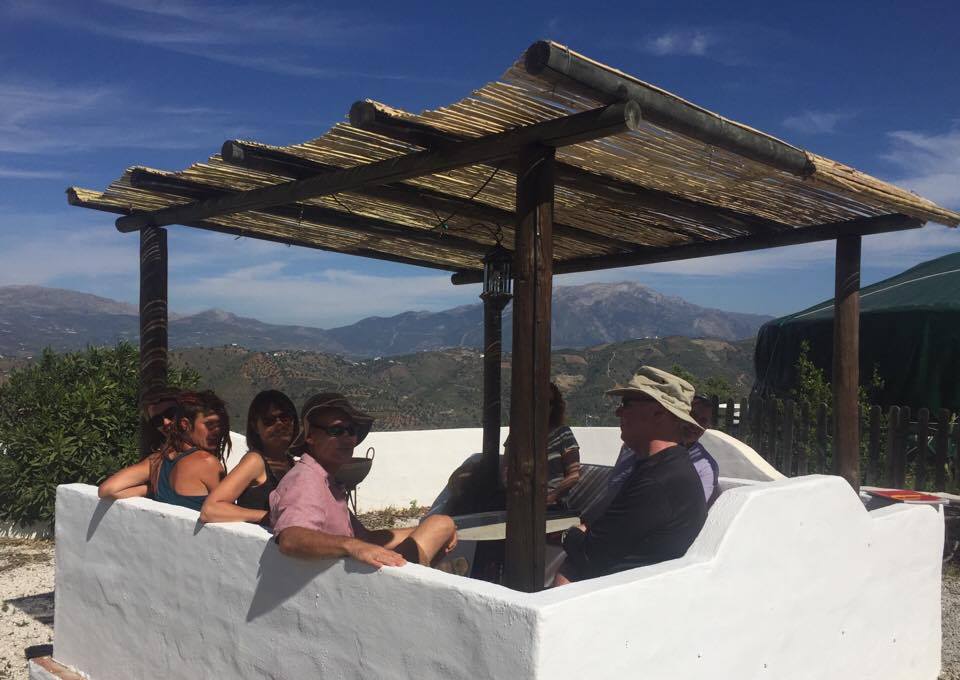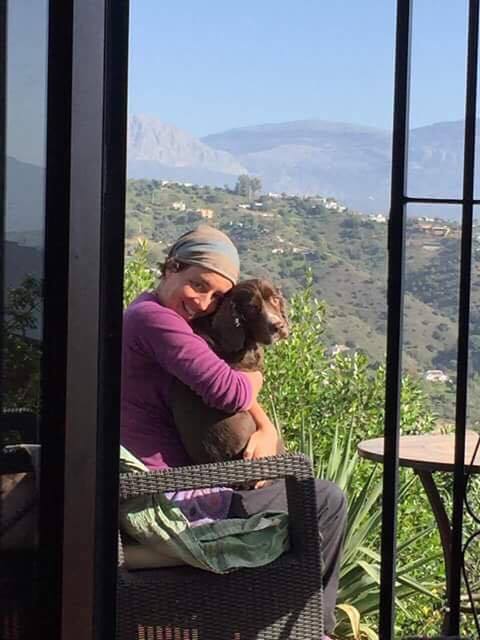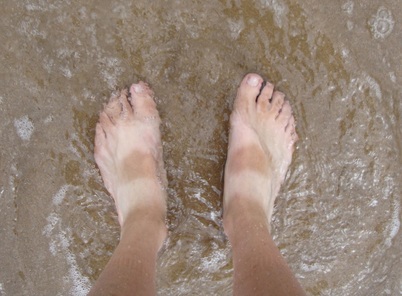|
Yesterday I had my first go at making "cheese" from nuts, (in this case, almonds from last years harvest here in our garden in Spain). Its been a food I've been thinking about making for a while and a quick Google search demonstrates making nut cheese is something that a lot of other folks are doing too! - I used a few ideas from others and added in some of my own for good measure. So here is the finished result this morning ...and now, how I went about it For a small cereal type bowl of finished cheese I soaked about 40 almonds for 24 hours in slightly salted water - I then rinsed them, and blended them with just enough water to cover, the juice of one large lemon and 2 cloves of garlic The mix was then placed in a sieve over a bowl and left in the fridge to drain for another 16 hours - chopped mint, parsley and chilli, along with salt, were added and mixed in well.
The result, a 'cream cheese' consistency and mild nutty gorgeous tasting cheese to use as a topping, filling or spread. Using a cheese cloth and pressure could produce a firmer cheese, taking the skins off the nuts would give a more 'cheese' colour, and adding an additional lemon would give a further 'tang' Earth Care - all the ingredients were grown in our garden with very little input Fair Shares - I think a lot of my friends would also like this yummy addition to a reduced dairy/vegan diet People Care - so many beneficial nutrients from the ingredients used. Ticks a big box in a plant based protein diet.
0 Comments
This time last year I wrote a post about how we had started to implement a design to improve the fertility and water retaining properties of the soil in our garden in Andalucia. Over the year we have already noticed a big difference in the structure of the soil and water retention in the areas we treated. This year, as planned, we decided to chip the fresh almond tree prunnings as they happened. These then included lots of leaves which added an increased nitrogen concentration to the chips. Like many topics in permaculture design there is an ongoing healthy discussion about the pros verses the cons of using woodchip as a mulch to improve soil. Rather than discuss these here, I have linked to some of the main points in other articles, at the end of this post. Our observations had indicated that here using wood chip as a mulch was likely to be beneficial and worth including as part of our soil design. After several weeks of sitting in a heap, being exposed to both heavy rainfall and warm sun, the chips had started to heat up and the inner area already had lots of evidence of fungal activity commencing. The beds we are building to grow lots of annual edible plants, were either mulched with a layer of goat manure or overwintered beans last year, which meant that they will tolerate the big spike of carbon the wood chips will initially bring, much more effectively. A deep layer of the beautiful chipped mixture was added to all the beds from last year, and as a mulch around the trees planted over the last 2 years too. Im going to be closely observing the areas mulched over the next year to analyse the immediate effects of the almond wood chip/leaf mix. I'll also be comparing the health and growth of the same species and varieties of annual edible plants: - planted 1) in the wood chipped mulched areas, 2) areas which had manure only added (last year) and 3) in areas of the garden where we have not changed the soil at all yet. I've read some great accessible articles about the use of wood chip in edible gardens, both benefits and possible challenges - some of my favourite ones are listed below Building garden soil with wood mulch - Mother Earth News Woodchips- the secrets to effortless, inexpensive biodynamic gardening - Mercola 5 things you should know about wood chip mulch - Reformation Acres Mulches and mulching - Royal Horticultural Society Why we should use woodchips better - The Telegraph  So, today I'm pleased to be able to co-ordinate some time to write, with it being the correct day to write about #ThreeThingsThursday. You can read more about this regular day of appreciation and gratitude here #1 - This week I was part of a fab group of people in my local community in Spain, who got together to chat about composting toilets! We met at Trinity and Paul's home, who are keen have a composting loo as part of their guest facilities. As a group we came up with hopefully what will be a great design for them. I'll hopefully be writing more about the compost loo here as the design progresses! We also got to see some of the beautiful permaculture inspired garden design work, Clair, another friend, had been undertaking on the land. #2 - Its been the second week of my annual leave from my nursing work, and I've really enjoyed spending many hours of each day sat in the sun reading books and hanging out with my furry family! #3 - bean, cucumber, courgette and squash seeds sown last week are already starting to make a very welcome appearance for the edible garden here in Spain
Chillies, almonds, sowing winter seeds, designing wild spaces, planting and cooking by the full moon, gifted food.....gratitude
Today we started to harvest our almonds. We have about 20 trees or so and the cases of the nuts have just started to split, meaning they are good to go! We are planning on using the shells and casings from the nuts as part of our mulching system this winter.
- Using Earth, Fire, Air, Water and Spirit to as a tool to design my journey to Andalucía The meaning of spirituality I connect with is one which is Earth based and includes being guided by, grounding in and celebrating the different moon and sun cycles which of course in turn determine our patterns of days, months, seasons. Central to this form of spiritual experience are the 5 elements - Earth, Fire, Air, Water and Spirit. These aspects are deeply linked to my permaculture life, work and activism. This year I have undergone a big life change from being a hill farmer and palliative care nurse in a remote part of the Yorkshire Dales, to moving to the hills of Andalucía, Spain with my partner, dogs and cats, to a house with just under 2 acres of land. This post shows how I have used the 5 Elements to explore how my knowledge and practice of permaculture can be transferred and adapted to my next life chapter design. EarthIn the Dales I spent years using permaculture tools to improve the health of the soil on the farm. Carefully designed grazing systems with a wide diversity of agricultural animals made big differences to the biodiversity in the grazing land and the edge with forestry land. I used animal manure combined with structures such as raised beds, hot beds, polytunnels, and then lots of successional planting. This greatly improved the fertility of the soil and also generated extra heat to be able to grow a range of species and variety of both annual and perennial plants I never thought possible. Here in Andalucía, the soil is dry, rocky, dusty and steep. I wont be farming any agricultural animals so I need to design how I am going to create and maintain the highest level of soil fertility as I can. Many different perennial and annual plants grow here that I have no experience in growing before so there is much learning to be done. The Earth Element is also about ensuring life force and motivation is given to other aspects of life, and I intend to use the specific qualities from this element to design and carry out some of the ideas and projects on my ‘to do list for my move here. This will include looking at what I will do in terms of my right livelihood, creativity and taking responsibility for my own health. Designing for this diversity should help to ensure that my life here is as resilient as possible. FireWinters were long and cold in the Dales. Soon after we arrived there we invested in a heating system that heated the cottage there well, provided hot water and allowed us to be able to cook slow stews and soups through burning local wood. We often needed to keep one stove lit for most of the year, so needed a constant supply of dry wood. So we also designed a storage system for the large amounts of wood needed, to be as effective of human energy and time as possible. Our outdoors fireplace was also a really core part of our lives, providing a focus to cook outdoors and celebrate events. Sun hours in our remote part of the Dales were very few and we designed food growing, animal care and our own holistic health to maximize the use of the available sunlight. We need to heat our house for the coldest months of the year here in Spain and are already planning a wood burning system and accessing local wood to burn. Wild fires are also a very real danger in the summer months and how to avoid them and then protect our home and animals if they do occur, is something that is really key to our future life here. The sun shines for about 340 days of the year at our new home which is a really big change for us Yields we can obtain from that amazing energy include growing a much more diverse and abundant range of food and the potential for heating water and generating electricity for power. The strength of the sun can also be damaging in the hottest part of summer, and creating shade for both our food growing and outdoor living spaces will be part of the design. Energy and action are also inspired by the element of Fire and I am in the process of using this inspiration to explore how I am going to take my permaculture work (lots of energy and action!) forward from here. I plan to finish my Diploma soon, but then what? And how will it integrate and balance with the other aspects of my life to make sure my energies are used as efficiently as possible? WaterIt rained a lot at our North Yorkshire home, with the yearly average being over 100 inches. Improving the compacted soil, and planting trees, (especially willow). helped to improve the impact of excess water on the grazing land. The raised beds and a human made drainage channel, (which used a wide water pipe, perennial plant growth and a mesh outlet, to avoid soil erosion), had a really positive impact in avoiding plants being damaged by excess water. Water here in the hills of Andalucía is precious. There is virtually no rain between April and September, and the winter rains are often short and very heavy, with potential for damage to land through flooding and erosion. Systems such as capturing and dispersing rainwater, utilizing grey water, optimizing organic matter in the soil, mulching and growing drought tolerant edible plants are already being considered as part of our design Water in the non-physical aspect guides our emotional selves. Water flows, as do our emotions. Healthy emotional health can mean working on aspects of our mental heal that we are ‘stuck’ in, so that positive flow can take place. How can I use permaculture principles and tools to promote my emotional well being during this transition time? Starhawk talks a lot about the connections of grief and the water element, (‘the well of grief’). Being mindful of the loss I have experienced over recent months and years will also feature in this part of my people care/self care designing. AirThe exposed location and height of the farm meant that there could be damaging winds through out the year. Restoring many of the barns and dry stone walls on the farm and planting trees along field edges improved the shelter and then health and welfare of our agricultural animals. Also choosing native hardy breeds of sheep, cows, pigs and poultry ensured they would thrive well despite the weather conditions that the strong gales brought with them. Where we chose to site the various edible gardens, raised beds, polytunnel, planting further windbreaks and then choosing type and variety of edible plants designed for short growing seasons, meant we could protect our growing spaces from winds that contributed towards limits to maximum potential. The winds at our new home can also be strong, and especially so in the winter Designing our food growing areas to include shelter against strong winds will make a huge difference to the varieties of vegetables, fruits and herbs we can grow and the length of the growing season they will have. Communication and connecting is the inner strength from Element of Air, and here in Andalucía there is an abundance of different factors emerging for this - making beneficial connections with new friends, community and neighbours. Sharing permaculture knowledge and experience with them: Finding systems to have positive communication with friends and family now many miles away: and engaging further with parts of the global permaculture community particularly those who are undertaking permaculture work in the local area or in similar geographic and climatic locations. SpiritGlennie Kindred describes the Fifth Element, Spirit, as ‘the force that unites all the actions of the elements together, so that there is no separation….’ Back in the Yorkshire my spiritual practice mainly focused around celebrating the Wheel of the Year sun festivals, alongside the cycles of the moon, in connection with patterns the farming seasons. My nursing work and interest in using permaculture in designing how we die, also links deeply to spirit and that same cycle flow of life an death. In addition I spent time on a daily basis appreciating my spiritual connectedness with the land I worked on and grounding myself in the present, while honouring the power and energies of the five elements. It feels reassuring and comforting to know that in Spirit, the patterns and practices that have given me so much meaning and peace in the past will transfer to my future. There will be changes of course, open outdoor fires will be saved for winter months for example, and I can already see that the arrival of rain will be a time for celebration and gratitude…but fundamentally the wheel will keep turning just as it has done, and within it there is much here to connect to. Using the five Elements has been a really useful tool in my move here to Spain. As well as exploring the differences in using permaculture principles and ethics in our two homes, its also really helped me to identify some really beneficial connects between the knowledge and practice I feel confident about in my life in the Dales and my design for our resilient future here in Spain. Resources
The following resources have helped with this post The Earth Path – Starhawk Sacred Earth Celebrations – Glennie Kindred Earth Pathways Diary 2015 Earth Activist Training PDC, California 2013 - Starhawk and Charles Williams Growing food In a Hotter, Drier Land – Gary Paul Nabha The text from this post is published as an article "Permaculture and The Five Elements" in Permaculture Magazine Winter 2015 No 86 |
my blogregular updates and reflections about the permaculture designs in my life archives
December 2020
categories
All
|

























 RSS Feed
RSS Feed